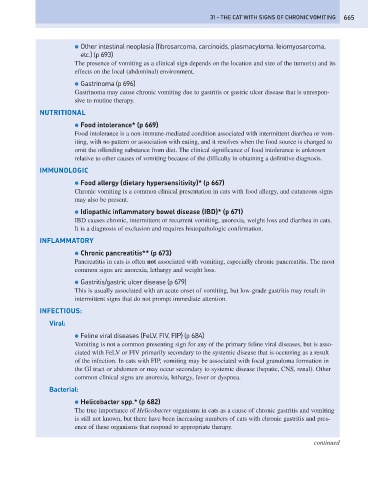Page 673 - Problem-Based Feline Medicine
P. 673
31 – THE CAT WITH SIGNS OF CHRONIC VOMITING 665
● Other intestinal neoplasia (fibrosarcoma, carcinoids, plasmacytoma, leiomyosarcoma,
etc.) (p 693)
The presence of vomiting as a clinical sign depends on the location and size of the tumor(s) and its
effects on the local (abdominal) environment.
● Gastrinoma (p 696)
Gastrinoma may cause chronic vomiting due to gastritis or gastric ulcer disease that is unrespon-
sive to routine therapy.
NUTRITIONAL
● Food intolerance* (p 669)
Food intolerance is a non-immune-mediated condition associated with intermittent diarrhea or vom-
iting, with no pattern or association with eating, and it resolves when the food source is changed to
omit the offending substance from diet. The clinical significance of food intolerance is unknown
relative to other causes of vomiting because of the difficulty in obtaining a definitive diagnosis.
IMMUNOLOGIC
● Food allergy (dietary hypersensitivity)* (p 667)
Chronic vomiting is a common clinical presentation in cats with food allergy, and cutaneous signs
may also be present.
● Idiopathic inflammatory bowel disease (IBD)* (p 671)
IBD causes chronic, intermittent or recurrent vomiting, anorexia, weight loss and diarrhea in cats.
It is a diagnosis of exclusion and requires histopathologic confirmation.
INFLAMMATORY
● Chronic pancreatitis** (p 673)
Pancreatitis in cats is often not associated with vomiting, especially chronic pancreatitis. The most
common signs are anorexia, lethargy and weight loss.
● Gastritis/gastric ulcer disease (p 679)
This is usually associated with an acute onset of vomiting, but low-grade gastritis may result in
intermittent signs that do not prompt immediate attention.
INFECTIOUS:
Viral:
● Feline viral diseases (FeLV, FIV, FIP) (p 684)
Vomiting is not a common presenting sign for any of the primary feline viral diseases, but is asso-
ciated with FeLV or FIV primarily secondary to the systemic disease that is occurring as a result
of the infection. In cats with FIP, vomiting may be associated with focal granuloma formation in
the GI tract or abdomen or may occur secondary to systemic disease (hepatic, CNS, renal). Other
common clinical signs are anorexia, lethargy, fever or dyspnea.
Bacterial:
● Helicobacter spp.* (p 682)
The true importance of Helicobacter organisms in cats as a cause of chronic gastritis and vomiting
is still not known, but there have been increasing numbers of cats with chronic gastritis and pres-
ence of these organisms that respond to appropriate therapy.
continued

